Rehabilitating our property OR how to choose a small farm
This is a post from February 2011, back when we only had Eight Acres and were working on fixing the soil fertility and clearing the paddocks. A few thoughts on what you can do with a small property.
This is the second small farm/acreage property that we've lived on. The first one, in the Lockyer Valley, was fairly flat and cleared of all but a few tall trees, with two good dams and few rocks or weeds. We were hoping to find something even nicer when we moved to Nanango, but we couldn't find anything in our price range, so settled for one of the cheapest options we could find.
We didn't know how lucky we were with the first property! It was selected by Pete for its dirt bike riding potential more than any small farming ideas, but it worked out just perfectly when our focus changed to self-sufficiency. The place we found at Nanango is steep, rocky, weedy and the dam was quite saline when we first arrived, but it was cheap and had a perimeter fence.
This lead us to investigate how we could rehabilitate the property. Unfortunately, most small acreage blocks (5-20 acre) will have similar problems, that's why they were split off the main farm in the first place. They tend to have less fertile land and more rocks or be a steep area of the farm. This is compounded by the popularity of horses on small blocks. It seems that horse owners often underestimate how much a horse will eat, or overestimate how many horses a small property will sustain, in any case, horses are picky eaters and can quickly strip all the good grass, leaving only weeds. We were lucky that our property had six months to recover from the previous owner's horses before we moved in. We were then very careful to rest the paddocks to let the grass grow back in between grazing. We have seen some devastated properties around to Lockyer Valley due to overstocking of horses.
We have tried to follow the principles of Natural Sequence Farming described in Peter Andrews' books "Beyond the Brink" and "Back from the Brink". Most of the these techniques have to be adapted for small properties as some of our problems, such as the salinity, originate on a neighbour's property and its difficult to do much about that, but we are doing what we can within our own boundaries.
Firstly, we have been removing any weeds that are poisonous to the cattle (especially lantana) and any small wattle saplings, and then slashing the rest of the paddock. This provides plenty of mulch to start to build up the soil fertility again. We have also been putting out grass seed and trace minerals to improve the pasture. This is starting to work (and we've been very lucky with this recent rainy season) and the paddocks are becoming far more productive.
We are also picking up rocks as we find them and using them in our drain. Unfortunately, with our steep property, the shed has been placed so that during heavy rain, water pools around the base and leaks in. Our neighbour used his tractor to dig out a drain around the shed and we are trying to get some more grass to grow on the slope above it to stabalise it. We also need to fence it off to keep the steers out so they don't stamp all over it. (See more about how we've improved this eroded area here).
We would like to do more about the dam salinity problem, but it seems to be coming from our neighbour's property. We have walked around and tested all the dams in our immediate area with a conductivity meter and found that the salt is coming from our neighbour's dam and moving across our property and into the neighbours on the other side. We suspect that the saltiest dam has been dug too deep and hit a layer of underground salt water. Peter Andrews talks about this in his books. We think the only long-term solution would be to fill in the neighbour's dam, which is too salty for stock to drink from anyway, but they are not interested in stock, so they won't be doing that. Our dam has been around 5000 ppm since we moved in, and lower now since all the rain, so its still ok for our steers, but no good for the garden or the chooks.
Overall, when looking for an acreage property, I recommend that you take a conductivity meter, or look for signs of salinity in the dam (salt crystals around the edge, salty smell/taste to the water) and take a crow bar so you can have a good look at the soil structure. We were in a hurry to buy and just chose something cheap, but if we had more time to compare properties it would have helped to know more about the dam water and the soil (you can even take samples and get them tested if you're really keen!). If you are happy to put some work in, you can pick up a cheap property that needs some rehabilitation.
Do you have any other suggestions for rehabilitation?
See more information about soil and soil testing here.
Where should I start with a new property? See this post.
** 2017 note: We found that the dam is really no good when we have long periods of dry weather. We were lucky that the neighbour with the less salty dam has let us take water from his dam for our cattle. Water really is essential for homesteading, so do make sure you test the water before you buy. This is part of the reason we decided to buy a larger property with more secure water int he form of several dams and a bore.**
This is the second small farm/acreage property that we've lived on. The first one, in the Lockyer Valley, was fairly flat and cleared of all but a few tall trees, with two good dams and few rocks or weeds. We were hoping to find something even nicer when we moved to Nanango, but we couldn't find anything in our price range, so settled for one of the cheapest options we could find.
We didn't know how lucky we were with the first property! It was selected by Pete for its dirt bike riding potential more than any small farming ideas, but it worked out just perfectly when our focus changed to self-sufficiency. The place we found at Nanango is steep, rocky, weedy and the dam was quite saline when we first arrived, but it was cheap and had a perimeter fence.
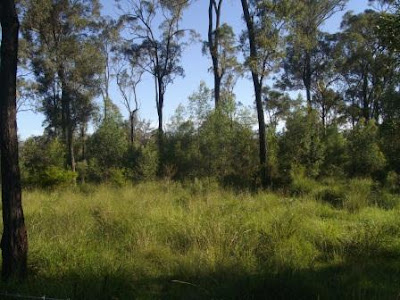 |
| One of the paddocks that we haven't cleared yet. |
This lead us to investigate how we could rehabilitate the property. Unfortunately, most small acreage blocks (5-20 acre) will have similar problems, that's why they were split off the main farm in the first place. They tend to have less fertile land and more rocks or be a steep area of the farm. This is compounded by the popularity of horses on small blocks. It seems that horse owners often underestimate how much a horse will eat, or overestimate how many horses a small property will sustain, in any case, horses are picky eaters and can quickly strip all the good grass, leaving only weeds. We were lucky that our property had six months to recover from the previous owner's horses before we moved in. We were then very careful to rest the paddocks to let the grass grow back in between grazing. We have seen some devastated properties around to Lockyer Valley due to overstocking of horses.
We have tried to follow the principles of Natural Sequence Farming described in Peter Andrews' books "Beyond the Brink" and "Back from the Brink". Most of the these techniques have to be adapted for small properties as some of our problems, such as the salinity, originate on a neighbour's property and its difficult to do much about that, but we are doing what we can within our own boundaries.
Firstly, we have been removing any weeds that are poisonous to the cattle (especially lantana) and any small wattle saplings, and then slashing the rest of the paddock. This provides plenty of mulch to start to build up the soil fertility again. We have also been putting out grass seed and trace minerals to improve the pasture. This is starting to work (and we've been very lucky with this recent rainy season) and the paddocks are becoming far more productive.
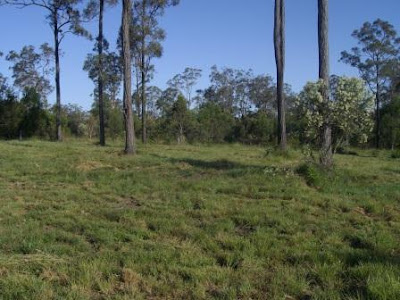 |
| One of the cleared paddocks. |
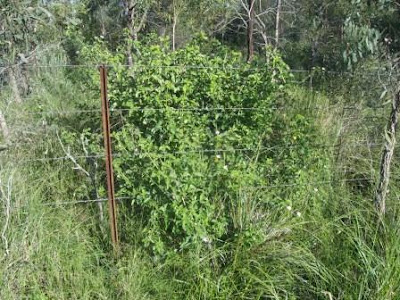 |
| Some of our neighbour's Lantana. |
We are also picking up rocks as we find them and using them in our drain. Unfortunately, with our steep property, the shed has been placed so that during heavy rain, water pools around the base and leaks in. Our neighbour used his tractor to dig out a drain around the shed and we are trying to get some more grass to grow on the slope above it to stabalise it. We also need to fence it off to keep the steers out so they don't stamp all over it. (See more about how we've improved this eroded area here).
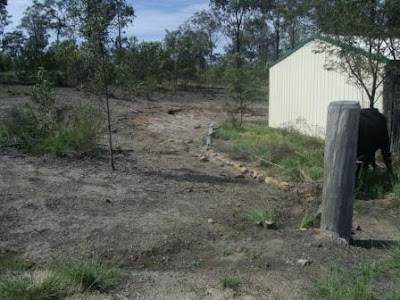 |
| The drain around our shed when arrived (Bruce on the edge of the shot) |
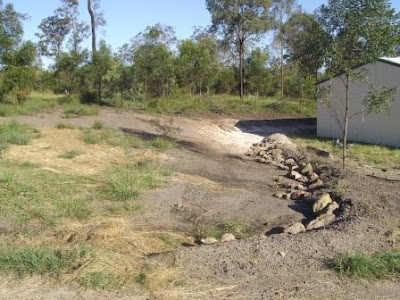 |
| Our remodelled drain, soon to be fenced off from the cattle. |
 |
| Our dam turned out to be a little saline, but is ok for the cattle to drink. |
We would like to do more about the dam salinity problem, but it seems to be coming from our neighbour's property. We have walked around and tested all the dams in our immediate area with a conductivity meter and found that the salt is coming from our neighbour's dam and moving across our property and into the neighbours on the other side. We suspect that the saltiest dam has been dug too deep and hit a layer of underground salt water. Peter Andrews talks about this in his books. We think the only long-term solution would be to fill in the neighbour's dam, which is too salty for stock to drink from anyway, but they are not interested in stock, so they won't be doing that. Our dam has been around 5000 ppm since we moved in, and lower now since all the rain, so its still ok for our steers, but no good for the garden or the chooks.
Overall, when looking for an acreage property, I recommend that you take a conductivity meter, or look for signs of salinity in the dam (salt crystals around the edge, salty smell/taste to the water) and take a crow bar so you can have a good look at the soil structure. We were in a hurry to buy and just chose something cheap, but if we had more time to compare properties it would have helped to know more about the dam water and the soil (you can even take samples and get them tested if you're really keen!). If you are happy to put some work in, you can pick up a cheap property that needs some rehabilitation.
Do you have any other suggestions for rehabilitation?
See more information about soil and soil testing here.
Where should I start with a new property? See this post.
** 2017 note: We found that the dam is really no good when we have long periods of dry weather. We were lucky that the neighbour with the less salty dam has let us take water from his dam for our cattle. Water really is essential for homesteading, so do make sure you test the water before you buy. This is part of the reason we decided to buy a larger property with more secure water int he form of several dams and a bore.**



















Leave a comment